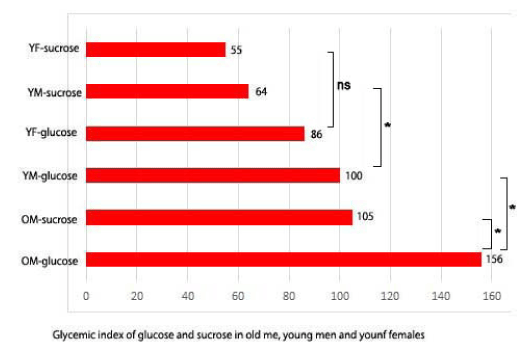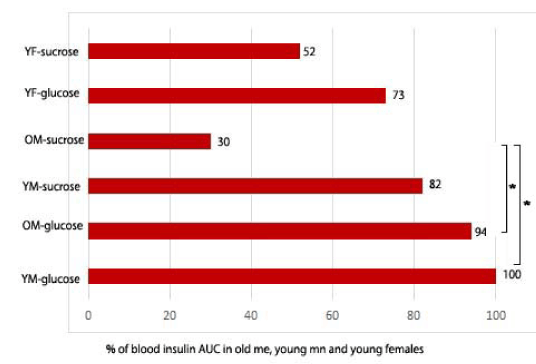Abstract
Background: GI (glycemic index) is used to show the potency of foods to increase blood glucose. No research has been carried out about gender and age differences of GI of foods of distinct structures such as glucose and sucrose. We wanted to know if there is a big difference in GI depending upon sex and age to take foods.
Methods: We gave 50 gm of either glucose or sucrose in a cross over study to three groups of healthy old (n=44, mean age: 62.4 ± 9.6), young men (n=36, mean age: 20.6 ± 1.6) and women (n= 35, mean age: 21.2 ± 0.7).
Results: when GI of young men who took, glucose was set 100, GI of old men was 156. GI of young females who took sucrose was 55 When blood insulin levels of young men were set 100, insulin levels of old men who took sucrose were 30.
Conclusion: GI of glucose of old men were 156% compared to GI of young men. GI of young females who took sucrose was 55% of GI of young men who took glucose. These results indicate that GIs were different between old and young men and young females even if they took the same foods with distinct structure such as glucose and sucrose.
Key words
sucrose, glucose, BMI, insulin, glycemic index, gender, age
Introduction
Term of glycemic index (GI) has been introduced by Jenkins and coworkers in 1981 [1] and is defined as the area under the blood glucose curve measured two hours after consuming 50 g of test carbohydrates in relation to 50 g of glucose. The use of GI has been controversial [2-5]. So far influences of gender or age on GI have not been studied.
We showed that that GI is very much different between old and young men even if the same foods with distinct structures are given, and insulin release to increase in glucose in young men is more sensitive than old men even if the same foods with distinct structures are given [6]. We also showed that GI was influenced by gender [7]. We now summarized these results in this article.
Methods
Male and female college students or men older than 50 were requested to participate in the experiments. We carefully assessed their health and allowed those who do not smoke, with no sign of health problems such as diabetes and hypertension, as well as no history of serious disease, to participate. Participants were provided with a questionnaire relating to self-administered diets they may have followed in the past. From these completed questionnaires, we calculated their past intakes of energy, carbohydrate, fat, and protein. We did not calculate energy uptake related to alcohol drinks, but young men drink alcohol more than young women.
Measurements of blood variables: After fasting overnight, participants were randomly assigned to groups. Depending on their group, each participant received a 550-mL solution containing 50 g of glucose or sucrose (or 500 mL water as a control). Either 50 g of glucose or sucrose was added and dissolved in each bottle containing 500 mL of water.
Participants were requested not to eat anything after 09:00 PM on the previous night and not eat anything for breakfast the following morning. Between 9:00 AM and 10:00 AM, blood was sampled using a syringe, and participants were given either glucose or sucrose solution or water as a control. We measured blood glucose using a finger stick (TERUMO kit) before and 15,30,60, and 120 min after the administration of glucose or sucrose. Furthermore, other plasma factors were measured after plasma was separated from blood. Ethylene diamine tetra acetic acid (EDTA) was used as an anticoagulant. Insulin was measured by the CLEIA (chemiluminescent immunoassay) method.
Ethics: This work was approved by the ethical committees of Showa Women’s University (15-02) and the NPO “International projects on food and health” (15-01) and was conducted in accordance with The Code of Ethics of the World Medical Association (Declaration of Helsinki) for experiments.
Statistics: The results are presented as means ± SEM. Statistical significance of the differences between groups was calculated according by one-way ANOVA. When ANOVA indicated a significant difference (P<0.05), the mean values of the treatment were compared using Tukey's least significant difference test at P<0.05
Results
Figure 1 shows that GI of old men given glucose was 156 when GI of young men was set 100. GI of young men given sucrose was 64 when GI of young men was set 100. Figure 2 describes AUC (area under the curve) of plasma insulin levels when glucose or sucrose was given to young men and women, an old man compared to insulin levels of young men who took glucose.

Figure 1. Glycemic index of glucose and sucrose given to old men, young men and women [OM-glucose: GI of old men given glucose; OM-sucrose: GI of old men given sucrose; YM-glucose: GI of young men given glucose; YF-glucose: GI of young females given glucose; YM-sucrose: GI of young men given sucrose; YF-sucrose: GI of young women given sucrose; *: p<0.05; ns: non-significance]

Figure 2. AUC (area under the curve) of plasma insulin levels when glucose or sucrose was given to young men and women, an old man [*: p<0.05]
Sucrose levels were significantly lower compared to those of young and old men given glucose.
Discussion
Glycemic index was shown to be a useful indicator of dietary carbohydrate uptake. Oba et al. [8] reported the relationship among dietary glycemic index, glycemic load and carbohydrate uptakes and the risk of mortality from strokes and indicated that the hazard ratios increased in high dietary GI in women. On the other hand, Fan J et al. [9] reported that gender significantly modified the effects of glycemic index and glycemic load on cardiovascular risk, and high glycemic load level was associated with higher risk of cardiovascular disease in women, but not in men. It has been recognized that diet plays a major role in increasing the risks of cardiovascular diseases. Dietary GI and dietary GL are used to evaluate the glycemic properties of the diet. The dietary GL was shown by Nurses Health Study to be associated with the risk of cardiovascular disease [10] and later with hemorrhagic stroke [11] and these associations were shown to be the most evident in overweight women in both studies. Later, similar findings for CVD risk have been reported in several, but not all studies [12-14].
These controversial re2021 Copyright OAT. All rights reservbasic studies of age or gender differences were not well performed. In this study, we showed that GI was so much different between young and old men even if the same amounts of glucose were given and GI of sucrose was not 50% of GI of glucose even if the amount of glucose in sucrose was 50% of glucose.
Since blood insulin levels of old men were like those of young men, the sensitivity to insulin may be higher to young men than old men. The release of insulin when sucrose was given to old men may be lower than the release of insulin in young men. These data clearly show that we must examine the roles of age and gender in GI more precisely to know dietary effects on plasma levels of glucose.
Acknowledgment
Experiments were designed and performed by all the authors. AT wrote a manuscript. Statistical analyses were done by TT. All authors read the manuscript and approved the final version. All the authors had responsibilities for the final content. Ogawa, M.: No conflicts of interest for any member of researchers.
Financial support
This study was supported by grants by Ito Memorial Foundation and NPO “International Projects on Food and Health.”
References
- Jenkins DJ, Wolever TM, Taylor RH, Barker H, Fielden H, et al. (1981) Glycemic index of foods: a physiological basis for carbohydrate exchange. Am J Clin Nutr 34: 362-366. [Crossref]
- Atkinson FS, Foster-Powell K, Brand-Miller JC (2008) International tables of glycemic index and glycemic load values: 2008. Diabetes Care 31: 2281-2283. [Crossref]
- Vega-López S, Ausman LM, Griffith JL, Lichtenstein AH (2007) Interindividual variability sensitivity to and intra-individual reproducibility of glycemic index values for commercial white bread. Diabetes Care 30: 1412-1417.
- Mulholland HG, Murray LJ, Cantwell MM (2008) Glycemic index, glycemic load, and chronic disease risk. Am J Clin Nutr 88: 475-476. [Crossref]
- van Bakel MM, Slimani N, Feskens EJ, et al. (2009) Methodological challenges in the application of the glycemic index in epidemiological studies using data from the European Prospective Investigation into Cancer and Nutrition. J Nutr 139: 568-575.
- Takao T, Ogawa M, Ishii Y, Shimizu F, Takada A (2016) Different glycemic resposes to sucrose and glucose in old and young male adults. J Nutr Food Sci 6: 460.
- Ishii Y, Shimizu F, Ogawa M, Takao T, Takada A (2016) Gender differences in foods uptakes, glycemic index, BMI, and various plasma parameters between young men and women in Japan. Integr Food Nutr Metab 3: 427-430.
- Oba S, Nagata C, Nakamura K, Fujii K, Kawachi T, et al. (2010) Dietary glycemic index, glycemic load, and intake of carbohydrate and rice in relation to risk of mortality from stroke and its subtypes in Japanese men and women. Metabolism 59: 1574-1582. [Crossref]
- Fan J, Song Y, Wang Y, Hui R, Zhang W (2012) Dietary glycemic index, glycemic load, and risk of coronary heart disease, stroke, and stroke mortality: a systematic review with meta-analysis. PLoS One 7: e52182.
- Liu S, Willett WC, Stampfer MJ, Hu FB, Franz M, et al. (2000) A prospective study of dietary glycemic load, carbohydrate intake, and risk of coronary heart disease in US women. Am J Clin Nutr 71: 1455-1461. [Crossref]
- Oh K, Hu FB, Cho E, Rexrode KM, Stampfer MJ, et al. (2005) Carbohydrate intake, glycemic index, glycemic load, and dietary fiber in relation to risk of stroke in women. Am J Epidemiol 161: 161-169. [Crossref]
- Sieri S, Krogh V, Berrino F, Evangelista A, Agnoli C, et al. (2010) Dietary glycemic load and index and risk of coronary heart disease in a large italian cohort: the EPICOR study. Arch Intern Med 170: 640-647. [Crossref]
- van Dam RM, Visscher AWJ, Feskens EJM, Verhoef P, Kromhout D (2000) Dietary glycemic index in relation to metabolic risk factors and incidence of coronary heart disease: the Zutphen Elderly Study. Eur J Clin Nutr 54: 726-731.
- Levitan EB, Mittleman MA, Håkansson N, Wolk A (2007) Dietary glycemic index, dietary glycemic load, and cardiovascular disease in middle aged and older Swedish men. Am J Clin Nutr 85: 1521-1526.


